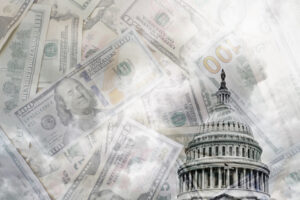
Is the USD Really Too Big To Fail?
The comments below are an edited and abridged synopsis of an article by Matthew Piepenburg
We are living in surreal times. Politics is driven more by self-interest than public service, markets are driven by debt rather than profits, and currencies are diluted by over-creation rather than being backed by real assets.
But amidst this surreal landscape, the dollar stands out as a rock, an often unloved yet constant force.
The USD: Too Big to Fail?
Regardless of opinions on the dollar, its central role in global finance cannot be denied. From the SWIFT and Eurodollar systems to the derivative and petrodollar markets, the USD’s influence is unmatched. Even though the USD is broken, debased, and inflated, it remains the world reserve currency, involved in over 80% of global FX transactions.
More critically, only the Fed can print the USD into existence, while the rest of the world can only lend it into existence, creating a perpetual cycle of debt and lending. This makes the USD the base money for most global debt instruments, underpinning a $330 trillion debt world.
Given this, one might argue the USD is too big to fail, right?
The Immortal Greenback?
Given the global demand for the USD and its role in credit markets, the system it supports will likely end only in economic or military upheaval. Dollar bulls argue that even a collapsing system would ironically strengthen the USD due to soaring UST yields. Hence, despite its flaws, the dollar remains king, a fact acknowledged by central bankers in Washington.
Gold Backing?
Talk of returning to a gold-backed dollar often recalls William Jennings Bryan’s 1896 “Cross of Gold” speech, warning that such a move would tighten credit and harm the average citizen. No country wants to be tied to a gold standard that limits their ability to print currency as needed. Hence, money remains what the strongest country declares it to be, and for now, that’s the USD.
Assuming Nothing (or History) Ever Changes
These conclusions hold only if the US remains the strongest global power. However, history is dynamic, and the US may not always hold this position. China, Russia, or India are significant players, but it’s unlikely they will replace the greenback. Thus, the USD remains the king of liquidity.
Even for those advocating de-dollarization, the BRICS+ nations are unlikely to agree on a gold-backed currency. They distrust the USD but also don’t trust each other enough to forgo their own currency-printing abilities. Yet, this doesn’t diminish gold’s rising role.
Going Around Rather than Replacing the Dollar
The real story isn’t about replacing the dollar but going around it with new price directions in black and gold. Central banks and nations are stacking gold, moving away from USD-denominated trades. For instance, Russia and China are using yuan for oil trades and settling in gold, bypassing the dollar.
The BRICS+ nations are moving away from the dollar, trading in local currencies and settling in gold. This shift indicates a preference for gold over the USD as a reserve asset.
Conclusion
While the USD may remain strong relative to other fiat currencies, gold consistently holds its value better. There’s a stronger “king” than the USD, and it’s always been there—gold. Central bankers may not want you to see it, but gold, with its timeless value, is the true king. Which king will you choose?

